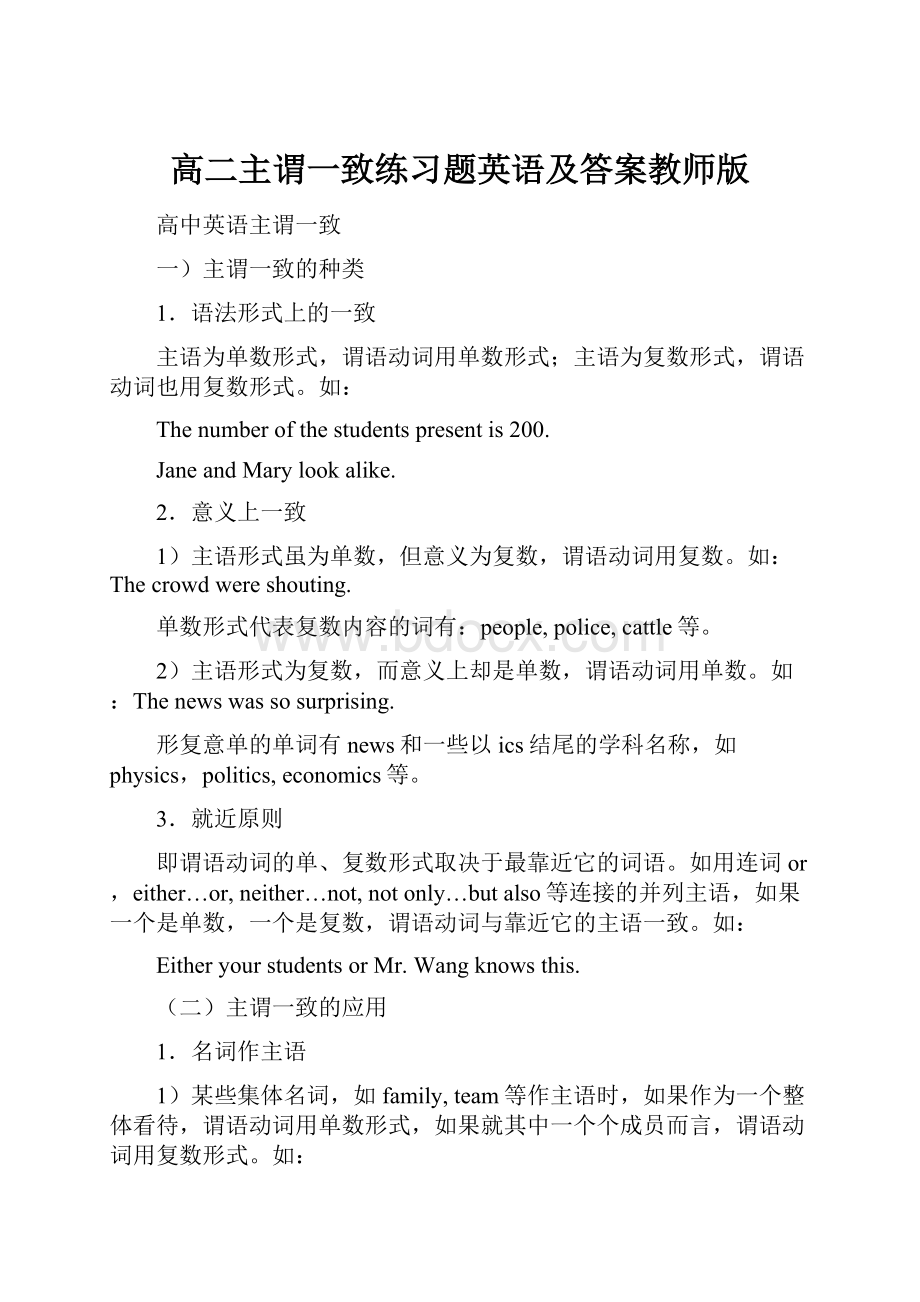高二主谓一致练习题英语及答案教师版.docx
《高二主谓一致练习题英语及答案教师版.docx》由会员分享,可在线阅读,更多相关《高二主谓一致练习题英语及答案教师版.docx(89页珍藏版)》请在冰豆网上搜索。

高二主谓一致练习题英语及答案教师版
高中英语主谓一致
一)主谓一致的种类
1.语法形式上的一致
主语为单数形式,谓语动词用单数形式;主语为复数形式,谓语动词也用复数形式。
如:
Thenumberofthestudentspresentis200.
JaneandMarylookalike.
2.意义上一致
1)主语形式虽为单数,但意义为复数,谓语动词用复数。
如:
Thecrowdwereshouting.
单数形式代表复数内容的词有:
people,police,cattle等。
2)主语形式为复数,而意义上却是单数,谓语动词用单数。
如:
Thenewswassosurprising.
形复意单的单词有news和一些以ics结尾的学科名称,如physics,politics,economics等。
3.就近原则
即谓语动词的单、复数形式取决于最靠近它的词语。
如用连词or,either…or,neither…not,notonly…butalso等连接的并列主语,如果一个是单数,一个是复数,谓语动词与靠近它的主语一致。
如:
EitheryourstudentsorMr.Wangknowsthis.
(二)主谓一致的应用
1.名词作主语
1)某些集体名词,如family,team等作主语时,如果作为一个整体看待,谓语动词用单数形式,如果就其中一个个成员而言,谓语动词用复数形式。
如:
Hisfamilyisahappyone.
ThewholefamilyarewatchingTV.
这类名词有:
audience,class,club,company,crew,enemy,crowd,government,group,party,public,team等。
名词population一词的使用情况类似。
“agroup(crowd)of+复数名词”等短语之后的谓语动词也同样可用单数或复数,前者强调整体,后者强调各个部分。
2)某些集体名词,如people,police,cattle等,只当复数看待,谓语动词必须用复数。
如:
Thepolicearesearchingforthethief.
3)单、复数同形的名词主语时,谓语动词应根据意义决定单、复数。
如:
Asheepisoverthere.
Somesheepareoverthere.
4)名词所有格之后的名词被省略,这种情况一般只指商店、工厂、住宅等,作主语时,动词一般用单数。
如:
Thedoctor’sisacrossthestreet.
Myuncle’sisnotfarfromhere.
常见的省略名词有:
thebaker’s,thebarber’s,thecarpenter’s,theZhang’s等。
表示店铺的名词,一般作集体名词看待,但用作主语时,谓语动词往往用复数。
如:
Richardson’shavealotofgoodstosell.
5)当名词词组中心词为表示度量、距离、金额、时间、书名等复数名词时,往往可以根据意义一致的原则,把这些复数名词看作一个整体,谓语用单数形式。
如:
Threeyearshaspassedsincethen.
6)不定代词each,every,no所修饰的名词即使以and或逗号连接成多主语时,谓语动词仍用单数形式。
如:
Eachboyandeachgirlwantstogotothecinema.
7)如果主语有morethanone…或manya…构成,尽管从意义上看是复数内容,但它的谓语动词仍用单数形式。
如:
Morethanonestudenthasreadthebook.
Manyagirlhasbeenthere.
但是,“more+复数名词+thanone”结构之后,谓语动词一般多用复数形式。
如:
Moremembersthanoneareagainstyourplan.
8)一些有两个部分构成的名词表示衣物或工具作主语时,谓语动词通常用复数形式,例如:
glasses,clothes,trousers,shoes,compasses,chopsticks,scissors等。
但如果主语用“akindof,apairof,aseriesof等加名词”构成时,谓语动词一般用单数形式。
如:
Apairofshoeswasonthedesk.
9)thiskindofbook=abookofthiskind(这种书),其谓语动词用单数;短语thiskindofmen=menofthiskind=thesekindofmen(口语)(这一类人),但thiskindofmen的谓语动词用单数,menofthiskind和thesekindofmen的谓语动词用复数,allkindsof后跟复数名词,谓语动词用复数形式。
如:
Thiskindofmenisdangerous.
Menofthiskindaredangerous.
10)复数形式的单、复数同形名词作主语时,按意义一致原则,作用单数意义时,谓语用单数,反之,谓语用复数。
这类名词有:
means(方法),works(工厂),species(种类),Chinese,Japanese等。
如:
The(This)glassworkswassetupin1980.(这家玻璃厂建于1980年。
)
The(These)glassworksareneartherailwaystation.(这些玻璃厂在火车站附近。
)
当它们前面有a,sucha,this,that修饰时,谓语用单数;有all,such,these,those修饰时,谓语用复数,但means,nomeans,themeans等词前没有以上修饰词时,可用作单数,也可用作复数。
11)如果名词词组中心词是all,most,half,rest等词语,所指的复数意义,谓语动词用复数形式;反之,用单数。
如:
Allofmyclassmateslikemusic.
Allofthewaterisgone.
12)在主谓倒装的句子中,谓语动词的数应与其后的主语一致。
如:
Betweenthetwowindowshangsapicture.
2.由连接词连接的名词作主语
1)用and或both…and连接并列主语,谓语动词通常用复数形式。
如:
Plasticsandrubberneverrot.
Walkingandridingaregoodexercises.
但是,并列主语如果指的是同一个人、同一事物或同一概念时,谓语动词用单数形式,这时and后面的名词没有冠词。
如:
Truthandhonestyisthebestpolicy.
Thegirl’steacherandfriendisayoungdoctor.
Toloveandtobelovedisgreathappiness.
Goingtobedearlyandgettingupearlyisagoodhabit.
Aknifeandforkisonthetable.
2)当主语后面跟有aswellas,asmuchas,nolessthan,alongwith,with,like,ratherthan,togetherwith,but,except,besides,including,inadditionto等引导的词组时,其谓语动词的单、复数而定。
如:
Theteacheraswellasthestudentswasreadinginthelibrary.
3)以or,either…or,neither…nor,notonly…butalso等连接的名词(代词)作主语时,谓语动词的单复数应根据就近一致的原则。
如:
Tomorhisbrothersarewaitingintheroom.
Eitheryouorheistogo.
3.代词作主语
1)名词性物主代词作主语时,既可以用作单数,也可以用作复数,这取决于它所代替的是单数还是复数。
如:
Ours(OurParty)isagreatparty.
Yourshoesareblack,andmine(=myshoes)arebrown.
2)such,thesame起指示代词作用时,应根据其所指的内容来决定单、复数。
如:
Suchisourplan.Sucharehiswords.
3)关系代词who,that,which等在定语从句中作主语时,其谓语动词的数应与句中先行词的数一致。
如:
Thosewhowanttogopleaseputupyourhands.
Someoftheenergythatisusedbymancomesfromthesun.
4)疑问代词who,what,which作主语时,谓语动词可根据说话人所要表达的意思决定单、复数。
如:
Wholivesnextdoor?
ItisXiaoLiu.
Wholivenextdoor?
ItisZhangandLiu.
Whatproduce(s)heat?
5)不定代词any,either,neither,none,allsome,more等作主语时,有以下两种情况:
单独作主语时,视其在文中的意义,动词用单数或复数形式,例如:
Nowallhasbeenchanged.Allarepresent.
either,neither单独作主语时,谓语通常用单数。
但后接of时,若of的宾语为不可数名词,动词当然用单数形式,若of的宾语为复数名词或代词时,动词可以是单数,也可以是复数,在正式文体中,单数形式的动词更常用。
如:
Do(es)anyofyouknowhisaddress?
Noneofthemhas(have)seenthefilm.
4.分数、量词作主语
1)“分数或百分数+名词”构成的短语以及由“alotof,lotsofplentyof,alargequantityof,aheapof,heapsof,halfof+名词”构成的短语作主语时,其谓语动词要与短语中of后面的名词的数保持一致,这是因为短语中后面的名词是中心词,而短语中前面的量词是修饰语,例如:
Lotsofdamagewascausedbyfire.
Aboutthree-fourthsoftheearth’ssurfaceiscoveredwithwater.Three-fifthsoftheworkersherearewomen.
和这种情况类似的还有“anumberof+名词复数”,但是,“thenumberof+名词”的中心词却是number,试比较:
Anumberofstudentshavegonehome.
Thenumberofpagesinthisbookistwohundred.注意:
(large)quantitiesof修饰可数或不可数名词,其短语作主语时,谓语动词一般用复数,例如:
Quantitiesoffood(nuts)wereonthetable.
短语inquantity,inlargequantities意为“大量”;insmallquantities意为“少量”。
2)agreatdealof,alargeamountof修饰不可数名词,其短语作主语时,谓语动词通常用单数;largeamountsof修饰不可数名词,其短语作主语时,谓语动词通常用复数,例如:
Alargeamountof(Agreatdealof)damagewasdoneinaveryshorttime.
Largeamountsofmoneywerespentonthebridge.
3)表示数量的oneandahalf后,名词要用复数形式,但是其短语作主语时,谓语动词用单数形式,例如:
Oneandahalfbananasisleftonthetable.
4)halfof,(a)partof修饰可数名词单数及不可数名词时,谓语动词用单数,修饰可数名词复数时,谓语动词用复数。
5.名词化的形容词作主语
如果主语由“the+形容词(或过去分词)”结构担任时,谓语通常用复数,这类词有:
thebrave,thepoor,therich,theblind,theyoung,theold,thesick,thedead,thedeafanddumb,theoppressed,theinjured,thewounded,theunemployed等;但也有少数的过去分词与定冠词连用时指个别,则用单数。
如:
Theblindstudyinspecialschools.
Thedepartedwasawell-knownengineer.
这类形容词或分词如果要表示个体时,就要与名词man,person或表示人的单数连和,如:
anoldman,arichperson,the(a)woundedsoldier
6.从句作主语
1)由what引导的主语从句,谓语动词通常用单数,但所指的具体内容是复数意义时,谓语动词一般用复数形式,例如:
Whatweneedismoretime.
Whatweneedaredoctors.
2)在“oneof+复数名词++who/that/which”引导的从句结构中,关系代词who/that/which的先行词是靠近它的复数名词而不是one,因此,从句中的动词应该是复数形式。
如:
Thisisoneofthemostinterestingstoriesthathavebeentold.
但是当one之前有theonly等修饰语时,关系代词的先行词是one,而不是靠近它的复数名词,因此从句的动词应是单数形式。
如:
Shewastheonlyoneofthegirlswhowaslate.
强化练习题
1.NobodybutJane____thesecret.
A.knowB.knowsC.haveknownD.isknown
2.Allbutone_____herejustnow.
A.isB.wasC.hasbeenD.were
3.NotonlyIbutalsoJaneandMary____tiredofhavingoneexaminationafteranother.
A.isB.areC.amD.be
4.Alibrarywithfivethousndbooks_______tothenationasagift.
A.isofferedB.haveofferedC.areofferedD.hasoffered
5.Whenandwheretobuildthenewfactory_____yet.
A.isnotdecidedB.arenotdecided
C.hasnotdecidedD.havenotdecided
6.Thenumberofpeopleinvited______fifty,butanumberofthem____absentfordifferentreasons.
A.were,wasB.was,wasC.was,wereD.were,were
7._____ofthelandinthatdistrict_____coveredwithtreesandgrass.
A.Twofifth,isB.Twofifth,are
C.Twofifths,isD.Twofifths,are
8.Thisisoneofthemostinterestingquestionsthat____asked.
A.haveB.hasC.havebeenD.hasbeen
9.Betweenthentworowsoftrees_____theteachingbuilding.
A.standB.standsC.standingD.are
10.Allthatcanbedone___
A.hasbeendoneB.hasdoneC.havedoneD.weredone
11.Theyeach_____anewdictionary.
A.hasB.haveC.isD.are
12.Thesingerandthedancer______cometothemeeting.
A.hasB.haveC.areD.is
13.Ihavefinishedalargepartofthebook;therest_____moredifficult.
A.isB.areC.wasD.were
14.Thewounded_______bythehospital.
A.havebeentakeninB.hasbeentakenin
C.havetakeninD.hastakenin
KEYS:
1-5BDBAC6-10CCCBA11-14BBAA
强化练习
1.Neitherofthem______goingtothecinema.Bothofthem_____goingtothecinema.
A.is;areB.is;isC.are;wasD.are;is
2.Allbutone_____herejustnow.AllthatIwanttosay____this.
A.was;wereB.was;isC.were;isD.were;were
3.Anumberofstudents____goneforanouting.Thenumberofthestudents______increasingyear.
A.have;hasB.is;haveC.has;haveD.have;is
4.Someoftheoranges______turnedbad.Someofthemilk_______turnedsour(酸).
A.have;hasB.have;haveC.has;haveD.have;is
5.Eachstudent-____gotanEnglish-Chinesedictionary.Thestudentseach______adictionary.
A.have;hasB.has;haveC.have;haveD.has;has
6.There_____apen,aninkbottle,andsomebooksonit.There________somebowls,platesandaspoononit.
A.is;areB.are;areC.are;isD.is;is
7.Eitherthejudgeorthelawvers________wrong.Eitheryouorhe_______toblame.
A.is;areB.are;isC.are;areD.is;is
8.Hisfamily______allverywell.Hisfamily_______a“fivegood”one.
A.are;isB.is;isC.are;areD.is;are
9.Mybluetrousers______wornout.Onepairoftrousers______notenough.
A.is;areB.are;areC.is;isD.are;is
10.OurLeaguesecretaryandmonitor______theleadineverything.OurLeaguesecretaryandthemonitor____goodfriends.
A.take;areB.take;isC.takes;isD.takes;are
11.Thegirlaswellashisparents______abike.Notonlythestudentsbutalsotheprofessor_____surprisedatMary’sanswer.
A.have;wasB.have;wereC.has;wasD.has;were
12.Who_____thegirlsinginginthenextroom?
Who______thesepeopleoverthere?
A.are;areB.are;isC.is;areD.is;is
13.Mostofthestudents_____boys.Mostofhismoney_____spentonbooks.
A.are;isB.is;isC.are;areD.is